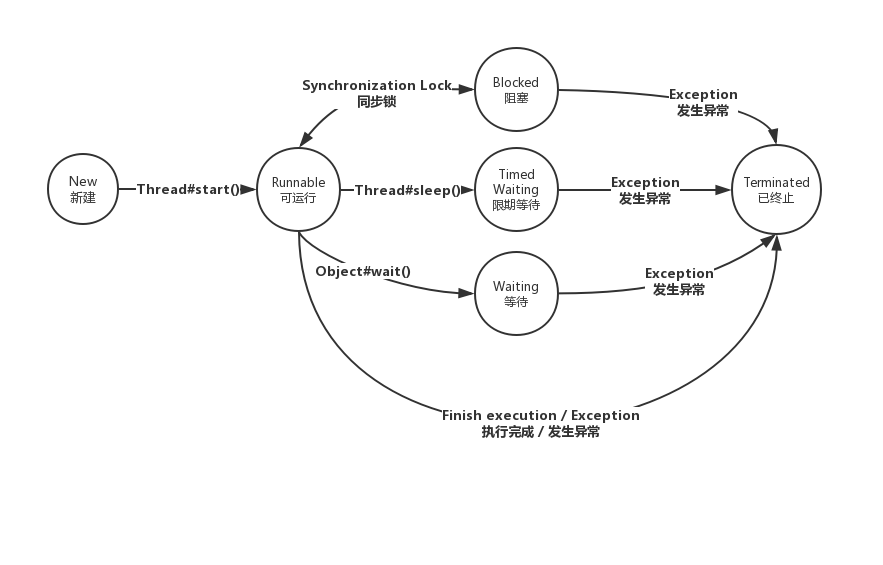本文记录一些Java多线程相关的概念性的知识。
线程的状态
新建(New) 线程已被创建,但是尚未启动
可运行(Runnable) 此线程在JVM中正在运行
阻塞(Blocked) 此线程正在等待获取一个监视锁(monitor lock),需要其他线程显式唤醒
等待(Waiting) 此线程正在无限期等待另一个线程完成某些工作
进入方法
退出方法
Object#wait()Object#notify()或Object#notifyAll()
Thread#join()被调用的线程执行完毕
限期等待(Timed waiting) 此线程正在有限期等待另一个线程完成某些工作
进入方法
退出方法
Thread.sleep()设定的休眠时间结束
Object#wait(long timeout)时间结束 / Object#notify() / Object#notifyAll()
Thread#join(long millis)时间结束 / 被调用的线程执行完毕
终止(Terminated) 线程结束
使用线程 见Java 如何创建和运行多线程
互斥同步 synchronized同步一个代码块 只作用于同一个对象,如多个Thread使用同一个Runnable时。一个线程若要使用此方法,则必须获得obj对象的锁。
1 2 3 4 5 public void something () { synchronized (obj) { } }
同步一个方法 1 2 3 4 5 public void synchronized something () { }
1 2 3 4 5 public void static synchronized aStaticMethod () { }
同步一个类 作用于整个类,即使两个线程使用同一个类的不同对象,也会进行同步。一个线程若要使用此方法,则必须获得该类的锁。
1 2 3 4 5 public void something () { synchronized (SynchronizationExample.class) { } }
ReentrantLockReentrantLock是java.util.concurrent包中的锁
1 2 3 4 5 6 7 8 9 10 11 12 13 14 15 public class LockDemo implements Runnable { private Lock lock = new ReentrantLock (); @Override public void run () { try { lock.lock(); for (int i = 0 ; i < 10 ; i++) { System.out.println(i + " " ); } } finally { lock.unlock(); } } }
1 2 3 4 5 6 7 8 9 10 11 12 public class Main { public static void main (String[] args) { LockDemo lockDemo = new LockDemo (); ExecutorService executorService = Executors.newCachedThreadPool(); executorService.execute(lockDemo); executorService.execute(lockDemo); } }
线程协作 Thread#join()在A线程中调用B线程的join()方法,会将当前线程挂起,直到目标线程结束。
1 2 3 4 5 6 7 8 9 10 11 12 13 14 15 16 17 18 19 20 21 22 23 24 25 public class MyRunnable implements Runnable { private AtomicInteger ticketCount = new AtomicInteger (5 ); @Override public void run () { System.out.println(Thread.currentThread().getName() + " started." ); while (true ) { try { Thread.sleep(500 ); } catch (InterruptedException e) { e.printStackTrace(); } if (ticketCount.get() > 0 ) { System.out.println(Thread.currentThread().getName() + " has " + ticketCount.getAndDecrement() + " tickets" ); } else { break ; } } System.out.println(Thread.currentThread().getName() + " stopped." ); } }
1 2 3 4 5 6 7 8 9 10 11 12 13 14 15 16 public class Main { public static void main (String[] args) throws InterruptedException { Thread t1 = new Thread (new MyRunnable ()); Thread t2 = new Thread (new MyRunnable ()); Thread t3 = new Thread (new MyRunnable ()); t1.start(); t1.join(); t2.start(); t3.start(); } }
执行结果如下:
1 2 3 4 5 6 7 8 9 10 11 12 13 14 15 16 17 18 19 20 21 Thread-0 started. Thread-0 has 5 tickets Thread-0 has 4 tickets Thread-0 has 3 tickets Thread-0 has 2 tickets Thread-0 has 1 tickets Thread-0 stopped. Thread-1 started. Thread-2 started. Thread-1 has 5 tickets Thread-2 has 5 tickets Thread-2 has 4 tickets Thread-1 has 4 tickets Thread-2 has 3 tickets Thread-1 has 3 tickets Thread-2 has 2 tickets Thread-1 has 2 tickets Thread-1 has 1 tickets Thread-2 has 1 tickets Thread-1 stopped. Thread-2 stopped.
wait(),notify(),和notifyAll()wait()将当前线程变为等待状态,notify()和notifyAll()将等待状态的线程唤醒。wait()方法必须在有锁(即synchronized)的代码块中执行。
当有多个线程处于等待状态时,notify()会任意选择一个线程来唤醒,选择的方式由JVM的实现来决定;而notifyAll()则会唤醒所有等待中的线程。
因为线程唤醒后,程序将会从wait()的下一条语句中开始执行,所以wait()方法应当总在while循环中调用,通过循环条件控制线程是否继续等待。
1 2 3 4 5 6 7 8 9 10 11 12 13 14 15 public class WaitNotifyDemo { public synchronized void before () { System.out.println("before" ); notifyAll(); } public synchronized void after () { try { wait(); } catch (InterruptedException e) { e.printStackTrace(); } System.out.println("after" ); } }
1 2 3 4 5 6 7 8 9 10 11 12 13 public class Main { public static void main (String[] args) throws InterruptedException { ExecutorService executorService = Executors.newCachedThreadPool(); WaitNotifyDemo waitNotifyDemo = new WaitNotifyDemo (); executorService.execute(waitNotifyDemo::after); executorService.execute(waitNotifyDemo::before); } }
执行结果:
